A Pretty
Girl Is Not a Malady
The
Evolution of Formula and the Celebrated Graphic Style of Cliff Sterrett
MANY EARLY
COMIC STRIPS EVOLVED from their initial formulaic treatments into something
quite different than originally intended. In Cliff Sterrett's Polly and Her
Pals, for example, we find a vivid instance of a strip that ran away with
its creator, leaving its conceptual notion far behind. Polly also
demonstrates better than most comic strips how amenable the art form is to
accommodating highly individual, even eccentric, graphic styles.
No
one who has ever seen Sterrett's mature artwork ever forgets it. It is not
only distinctive: it is unique. But Sterrett has another achievement in his
quiver: he is credited with creating the first pretty girl comic strip that
lasted. And Polly and Her Pals certainly lasted. It lasted from
December 4, 1912, until June 15, 1958—over 45 years. But I don't know that I'd
call it a "pretty girl strip."
In
the first place, Polly—for most of the strip's first two decades—was hardly
what I'd call pretty. She was more like, well—ugly. Fact is, Sterrett
couldn't draw a pretty girl. But he could draw a caricature of a pretty girl.
And, oddly enough, Sterrett's caricature was so deft that it established one of
the most potent visual stereotypes of the medium. In the second place, Polly wasn't really about a pretty girl at all, so how can it be called a
"pretty girl strip"? But let's do first things first.
About
Polly's face— Coulton Waugh, the medium's venerable historian with The
Comics (1947), is absolutely right when he says she was the "first of
a type—the famous comic type based on the French doll: bulging brow, tiny nose
and mouth, deep-set eyes." Sterrett's rendering of Polly's face (which he
did most often in profile) so acutely encoded the imagined essence of
"pretty girl" that it set the style for drawing the face of a pretty
girl in profile. 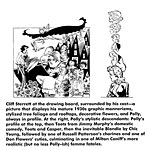 Countless comic strip females followed the fashion, beginning with Fritzi Ritz
and Tillie the Toiler and Winnie Winkle. Dumb Dora and Blondie and Casper's
wife Toots were all cast in the same mold—as were most of the nameless pretty
women walk-ons in the funnies. Even Russell Patterson and Don Flowers employed
the same durable doodle for the profiles of their lithesome beauties. And
traces of it can be found in even the more realistic treatment of girls' faces
in the work of cartoonists like Milton Caniff, Alex Raymond, John Prentice, and Frank Robbins. Of those renowned for pretty girls, perhaps only Alex
Kotsky has been successful in breaking the porcelain doll visage without
shattering at the same time his heroines' appealingly pretty appearance. Countless comic strip females followed the fashion, beginning with Fritzi Ritz
and Tillie the Toiler and Winnie Winkle. Dumb Dora and Blondie and Casper's
wife Toots were all cast in the same mold—as were most of the nameless pretty
women walk-ons in the funnies. Even Russell Patterson and Don Flowers employed
the same durable doodle for the profiles of their lithesome beauties. And
traces of it can be found in even the more realistic treatment of girls' faces
in the work of cartoonists like Milton Caniff, Alex Raymond, John Prentice, and Frank Robbins. Of those renowned for pretty girls, perhaps only Alex
Kotsky has been successful in breaking the porcelain doll visage without
shattering at the same time his heroines' appealingly pretty appearance.
Sterrett
scarcely thought he was setting a fashion, of course. He was just trying to
draw a pretty girl without offending the prudish public of the day. Her face,
therefore, was about all he had to work with. But he didn't care much about
his heroine anyway: by the time Polly's profile evolved, Sterrett was honing
his strip to take a bigger satirical slice at life than the frivolous
preoccupations of a pretty girl would allow for.
Sterrett
was working for the New York Evening Telegram on the eve of Polly's creation in 1912. Like George McManus (see Harv’s Hindsight for October 2009), he was doing an alternating anthology of comic strips
dealing with love and courtship and marriage and the tribulations of parenting
in the modern world—Before and After, When a Man's Married, and For
This We Have Daughters, a perspective in triptych on relations between the
sexes. Daughters contained the seed of Polly. It retailed the
trials to which a modern young woman subjected her somewhat old-fashioned
parents. The cast consisted of Pa and Ma and Molly. And a cat. (Don't forget
the cat.) This strip attracted the attention of the ever voracious press lord
William Randolph Hearst, always on the look-out for a new crowd-pleasing attraction
for his New York Evening Journal.
In
1912, an era was dawning, the age of the New Woman. The female population was
beginning to escape from the kitchen and the home and to take a place in the
surrounding social and vocational world. Sterrett capitalized on the
situation. In Daughters, he put the age-old struggle between the older
generation and its offspring in this new context, giving his strip a unique
twist: the daughter in Sterrett's strip had an ally in her mother because they
were both, in varying degrees, rebelling against the stereotypical role for
women that society had so long held sacred. And so poor Pa found himself
alone, his traditional sensibilities being constantly bombarded from every
quarter by new fashions in both clothes and manners, his once secure and sane
Victorian world in a state of continual comic turmoil.
Hearst
could see that this strip was in perfect tune with the times, and he quickly
bid for Sterrett's services. As was his custom, he offered the cartoonist
better financial rewards than the Evening Telegram, and by the end of
the year, Sterrett was in the Hearst stable, cranking out another version of For
This We Have Daughters, this one called Positive Polly.
Positive
Polly eventually became Polly and Her Pals, but not before it
evolved a bit. The theme of Daughters had not required a particularly
good-looking daughter. It was enough that she be relentlessly modern in her
conduct; she didn't need to be physically attractive. Since Hearst seemed to
want just another version of Daughters, Sterrett paid no particular
attention to Polly's physical charms. In fact, when he drew her, he made her
plain as a post. Within a month, however, her looks began to improve.
In
his Introduction to the Hyperion Press Polly and Her Pals (1977), comics
historian Bill Blackbeard speculates that Hearst had expected Sterrett
to produce an attractive version of the New Woman and that when he saw what the
cartoonist was doing, he ordered a change. And that makes sense, but we have
no indication that it was actually the press lord himself that inspired Polly's
improved appearance. Whatever the cause, by the early February 1913, Polly was
prettier—and more stylishly coiffured and attired. The pretty girl strip was
a-borning. But the improvement was attended by other troubles.
"You
have no idea of the strict censorship we were forced to work under in those
days," Sterrett complained to Martin Sheridan in his pioneering Comics
and Their Creators (1944). "In the first place, we couldn't show a
girl's leg above the top of her shoe. Furthermore, a comic strip kiss was
unheard of, and all the action had to take place and be completed before nine
o'clock."
He
felt the same restraint even after World War I. "Many letters of
condemnation arrived from clergymen who criticized my then-daring fashions.
And all I did was show a girl's ankle."
All
the while the pretty girl was gestating and occasionally showing her ankle, the
strip was changing. (Or perhaps not changing so much as "settling in"
on its true thematic foundation.) Given the strip's basic situation, the
comedy had to arise with Polly's father, the much put-upon Samuel Perkins. Paw
was the one whose outrage at the manners and mores of modern Youth inspired
laughter. And consequently—this being a comical strip rather than a serious
continuity—Paw soon became the star of the show, with Polly little more than
his foil (or, rather, the thorn in his side). Ditto Susie Perkins, the
embattled Paw's long-suffering spouse.
Paw's
stardom resulted in other subtle shiftings of emphasis in the strip. Once Paw
emerged as the source of the strip's comedy, Sterrett sought to wring
everything he could out of the circumstance. To this purpose, he surrounded
the old man with a cast of idiosyncratic secondary characters, each of whom
could introduce Paw to some aggravating aspect of modern life. In effect,
their assorted eccentricities were designed expressly to assail Paw with
modernity in all its variations and varieties.
Because
Sterrett's secondary characters all tended to be relatives of the Perkins
family who moved in to stay, before long their household was immense. First
came Delicia Hicks, a niece. Polly's age, she is not very bright and not very
attractive, and she thus offers another way of viewing the New Woman. Then
there was Ashur Url Perkins, a stupid and vain nephew who represents the male
half of the Younger Generation equation. Carrie Meek is Susie Perkins' sister,
a sharp-tongued widow whose chief function is to spoil rotten her daughter,
Gertrude—a brat of the first water. Aunt Maggie Hicks, however, proves a match
for the Meeks: a mountain of a woman, she is as powerful a personality as her
bulk would suggest. And there were others who showed up from time to
time--Uncle Ethelbert Armitage and his son (the same age—and temperament—as
Gertrude, with whom a rivalry quickly developed; ah, there was a battle of
giants). So large a household required servants, and they, too, added to Paw's
burden. A butler who was part of the original cast soon disappeared, and an
Oriental valet named Neewah became a permanent member of the ensemble. Ditto
three black servants (cook, maid, handyman)— Manda, Liza, and Cocoa.
Taken
altogether (as Paw had to take them)—personality quirks and tics with their
modern aspirations and interpretations—they constituted a formidable assault
force, all directed at poor Paw's tradition-bound proclivities. And so the
strip was about Paw's bouts with the Modern Age. With a sensibility rooted in
the Victorian times just past (as was the sensibility of most of the readership
of the day), Paw is forever taken aback by the antics of his more up-to-date
fellow cast members. (And so is his cat.) The strip would be more aptly titled The Trials of Paw Perkins, concentrating as it does on his attempts to
cope with his daughter, her beaux, his scapegrace nephew and his painfully
plain niece, his cousins and his uncles and his aunts and their spoiled
offspring.
As
penetrating a device for gaining comic insight into contemporary events as
Sterrett had concocted with these modifications to his strip's initial formula,
he is more revered today for his drawing style than his social commentary. And
rightly so. His satire, while adroit enough and humorous and wholly accomplished,
is not spectacular. His graphic style is.
Nor
is Sterrett much remembered today for his braving the censors or for his having
introduced to the funny papers what became the conventional way of drawing a
pretty girl's face. In both these departments (and in the arena of social
satire), he could be (and was) imitated. He is remembered—nay, acclaimed—for
that which is inimitable: his bizarre but decorative and supremely attractive
drawing style.
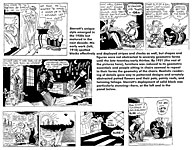 |
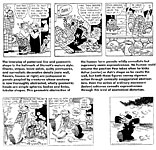 |
As
it reached its maturity in the twenties, Sterrett's style was a symphony of
patterned black and white designs and shapes. The syncopated rhythm of his
forms and lines did more than distinguish Sterrett's work with his own highly
individual stamp: it lifted Polly off the newspaper page. All other
strips in Polly's vicinity paled graphically into dull lines and drab
blobs. To say even this much—hyperbolic as it is—is not to say enough about
Sterrett's style. Unique, inimitable—spectacular. Still inadequate. These
words are words of appreciation not description. And until we can describe his
style, we will remain forever at once intrigued and baffled by it, tantalized
by the question: Just what, exactly, is it? How can it be described?
Waugh
made a noble attempt. He viewed Sterrett's unparalleled stylistic achievement
with a cartoonist's eye, a cartoonist's words: "Sterrett was an Old
Master at heart, one of the best and freest of them. In his portrayal of tiny
Maw and Paw, as well as the various relatives, he lets himself go and creates
an ultimate in wild stylization. These characters have a head ‘doodle' that
reminds one of a slightly flattened Edam cheese. Their noses are small rolls
stuck in front of two circles that touch. These are eyes, the irises of which
turn in together in a perpetual cross-eyed stare. The heads are squashed down
on tiny, neckless bodies whose leg extensions (what else can we call them?) are
sliced off to make enormous feet. Sterrett's anatomical phantasies reach their
limit with his animals; one, a very fine gray cat that accompanies Paw
[everywhere] and registers that tormented one's every mood, is perhaps his
noblest achievement. This cat marches with wild leg construction displaying ludicrous,
upturned feet."
But
there is more to Sterrett's style than this.
Waugh
senses an element of fine art in Sterrett's work, but the precision of his
description falters when he attempts to discuss it. "There is a sense of
pattern in Sterrett's work," he begins, "a very strong feel for
spotting and beauty of arrangement." And his verbal facility finally
trails off completely with the observation that Sterrett's drawing "has a
definite abstract art value."
Stephen
Becker, who chronicled the history of the medium the decade after Waugh
did, was not a cartoonist and therefore looked to art schools for guidance when
he came to Sterrett, and he does better at describing what he sees:
"In
the art professor's terms, Sterrett composed beautifully; each of his daily
panels is a delicate balance of black and white, and often one panel leads into
another through the simply rhythm of the lines. Sterrett usually dresses his
characters in striped or checked garments, and the play of line against shape
is masterly. If heads, hands, and feet were removed, what remained would be
pen-and-ink abstraction of a high order." This, at least, gives us
something to look for—something besides Edam cheeses and breakfast rolls,
imagery which, despite its antic accuracy, fails somehow to convey properly the
essence of Sterrett's style, its pervading sense of design.
Sterrett
himself supplied a clue to one of the guiding principles that apparently lies
behind his art. Sheridan unveils the clue: "The creator of Polly explained his unique style as an attempt to illustrate the futuristic in his
drawings. He portrays a cat with angles, furniture the same way. Sterrett's
is a symbolic world in figures."
"Futuristic."
The term is ambiguous as used by Sheridan. It can refer, simply, to things of
the future. But it also has a place in the lexicon of modern painting, and it
is to this that I think Sterrett was referring.
Aesthetic
theories of Futurism took root in the first decades of the 20th century at about the same time as Cubism flourished. These and other
contemporary theories of art—all lumped together under the rubric of “modern
art”— bloomed as artists reconceived the idea of art in the wake of
photography’s having superceded the traditional representational function of art.
Cubism made an effort to view (as it were) an object from all sides at once:
Cubists effectively flattened out the object, destroying the representational
character of their portrait of it by reducing it to its component geometric
shapes. The result was an arrangement of shapes and textures that was wholly
abstract. At the same time, there appeared to be a dynamic tension in the
relationship of the geometric forms—a suggestion of movement, of power in
motion.
Futurism
has its political and literary as well as its aesthetic aspects. Advocates of
this theory exalted speed, violent action, technology and machinery as evidence
of the power of the will in the dawning modern age, issuing great thumping
“manifestos” about “a racing automobile with its bonnet adorned with great
tubes like serpents with explosive breath ... a roaring motor car which seems
to run on machine-gun fire ... great-breasted locomotives, puffing on the rails
like enormous steel horses....”
Like
most modern art theorists, Futurists exuded obtuse argot because they were
groping for something that would rescue Art, and they didn’t know what,
exactly, that something was. So they beat drums of obscure and tortured verbal
formulations as if hoping that a useful “something” might be frightened out of
the surrounding undergrowth. As a result, it is almost impossible to find
artwork that embodies the lingo Futurists were bandying about. But we can look
at the pictures that these extravagances of language seemed to produce and see
various “somethings.”
For
my purpose here, it is enough to note that Futuristic painters concerned
themselves with a sense of motion that could be revealed in the
juxtapositioning of texture and shape. Obviously, there is in Sterrett's work
much concern with the same things—the patterning of stripes and checks, of
blacks and whites, of lines and shapes. But there is an even closer connection
to Futurism.
In
their championing of modernity and its machinery, some Futuristic painters
incorporated machine-age ideas into their paintings by representing organic and
animate objects as if they were composed of mechanistic parts—metal tubes,
cubes, cylinders, spheres, and the like. One of the more famous of the
painters often dubbed Futuristic was Fernand Leger, who “wanted his
works to rival industrial products in their robust logic. Transforming the
figure into a machine and conflating machines with humanity, Leger developed a
striking language of abstraction” (Cole and Gealt in Art of the Western
World). In Leger’s well-known painting "Luncheon, Three Women"
with its tubular forms, mechanical rigidity, and angular geometry, there is
much to remind us of Sterrett's work. Moreover, in the designs behind the
women are many of the patterns Sterrett often used. 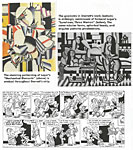
Leger's
painting was done in 1921. By the mid-twenties, artists everywhere (including
cartoonists whose work appeared in the humor magazines of the day) were
experimenting with Futurism's streamlined forms and startling patterns. And
Sterrett's mature style began to emerge in the last half of the twenties.
Clearly, some of the "abstract art value" that Waugh saw in
Sterrett's style is a Futuristic value, an indirect manifestation of Cubism.
But
there is another manifestation of modern abstract art in Sterrett's strip. If
the anatomy of his characters and the patterns and textures of their wardrobes
and surroundings are Futuristic, the shape of the "sets" in Polly is Surreal. Surrealism is another of the avant garde movements in modern art
that cropped up in Europe in the third and fourth decades of this century. It,
too, had a socio-political stance—opposition to the prevailing bourgeois view
of life. That, however, scarcely attracted Sterrett, whose strip, in making
Paw its protagonist, was at least sympathetic to the traditions of the middle
class if it did not actually uphold them. But the images that Surrealist
painters produced did attract Sterrett.
In
their images, Surrealist painters attempted to evoke a new realism by escaping
from the everyday mundane realities into the realm of a dreamlike or
nightmarish world where memory and the subconscious combined recognizable forms
with fantastic ones. This fusion of the real and the unreal would create a
higher form of realism—super-realism, or surrealism. So much for the theory.
The
most famous of the Surrealists is probably Salvador Dali (even though he
was, in effect, disowned by the most fervent of the fraternity because of his
rampant commercialization of their principles). 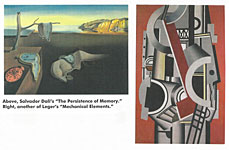 In his "The Persistence of Memory"
painting with its barren vista and limp melting watches, we have the very
emblem of Surrealism: a borderland between logic and magic where reality meets
fantasy, a dreamscape where an extreme perspective distorts space and where
seemingly incongruous objects and ideas are grotesquely juxtaposed in order to
appeal to an audience's subconscious feelings and impulses. And in Sterrett's
customary treatment of the settings through which his Futuristic characters
cavort, we see a clear invocation of Surrealistic imagery. In his "The Persistence of Memory"
painting with its barren vista and limp melting watches, we have the very
emblem of Surrealism: a borderland between logic and magic where reality meets
fantasy, a dreamscape where an extreme perspective distorts space and where
seemingly incongruous objects and ideas are grotesquely juxtaposed in order to
appeal to an audience's subconscious feelings and impulses. And in Sterrett's
customary treatment of the settings through which his Futuristic characters
cavort, we see a clear invocation of Surrealistic imagery.
Sterrett
began systematically toying with the realism of his pictures in the early
1920s—at the same time as he began spending summers (April through December) in
Maine in the artists’ colony of Ogunquit, where Sterrett must have encountered
other artists and probably engaged in (or was at least aware of) discussions
about the directions of modern art, including Futurism (in its mechanical
aspects) and Surrealism, both of which were then attaining some notoriety among
the avant garde.
By
the mid-1920s, Sterrett was relentlessly distorting perspective in the Perkins
home and reshaping common household furnishings into fantastical forms. The
Surreal settings are wildly inventive. Polly and her pals walked through
doorways that loomed into towering archways and sat in chairs that sprouted
awnings and other attachments. Throughout the environs, Sterrett scattered a
wild assortment of potted plants with whimsical mushroom-like blooms and fronds
and questing tentacles. And Sterrett used black more extensively than many of
his contemporaries, spotting solids for startling decorative effect throughout
daily installments and creating a cascade of patterns, often at screaming odds
with each other. While the occasional reprinting of a Sunday Polly here
and there over the years has acquainted us with the transcendent eccentricity
of Sterrett's style at its most impressive—that is, when in color—we have
seldom been exposed to the black-and-white version of that style, which is
equally impressive.
But
not every installment of the strip was Surreal. Sterrett abandoned the more
extreme of his Surrealistic renditions when his story required that the reader
comprehend immediately what the setting of the strip is. In a 1927 sequence,
for instance, Paw and company (including Polly) wind up marooned on a desert
isle. And there, the pictures, while still stylized, are far less Surreal than
they were when the action was set in the Perkins home among otherwise mundane
and familiar surroundings.
It
was as if Sterrett hit upon Surrealism as a way of relieving his ennui at
having to draw the same things all the time—the same chairs, the same lamps,
the same doorways, always the same household equipage. And in relieving his
own boredom, he gave his readers a visual treat. But when he had to use his
pictures to tell the story—when he knew the reader could get essential
narrative information only from the visual element in his strip—Sterrett was
careful to make his images more representational, less fantastical and
dreamlike. My guess is that Sterrett's interest in both Futurism and
Surrealism was exclusively an artistic interest not a political or social
interest. He was attracted to graphic productions of these two movements by
the pleasing designs and decorative imagery he found in them. And he
successfully adopted some of the conventions of a few of the Futurist and
Surreal painters by way of giving his comic strip visual variety.
To
label Sterrett's style Futuristic and Surrealistic is to run a risk.
Pigeon-holes have a tendency to become potholes, pitfall prisons, tiny cages of
categories out of which it is nearly impossible to extricate someone once he's
become so incarcerated. I don't mean to do that to Sterrett. We must remember
that Futurism and Surrealism constitute, after all, only aspects of "an
abstract art value" in Sterrett's art. There is more to Sterrett than
Futurism and Surrealism.
If
we return to Becker's aside about the abstract art that would result "if
head, hands, and feet were removed," we discover the rest of Becker's
statement: "But heads, hands, and feet are not removed, and Sterrett's
style is not abstract." Not entirely anyhow. There is more in Polly than abstract art. There are also Edam cheeses, breakfast rolls, and a cat
with wildly ludicrous leg construction. In short, there is high comedy in the
visuals as well as an element of abstract art. And it's the visual comedy that
brings us back to Sterrett again and again. It's the visual comedy that has
earned him a revered place in the history of the medium.
Sterrett's
Surrealism achieved its most flamboyant expression in the Sunday pages of the
late twenties. The pages are a riot of primary colors—rampant reds, succulent
yellows, and pristine blues. And Sterrett heightened the visual impact of his
palette with copious use of solid blacks, which made the colors seem more
brilliant by providing a stark contrast to their hues. Everywhere the
Surrealism of the backgrounds is enhanced by an outrageous patterning of checks
and stripes and other, more manic, geometries and designs. The pages are agog
in exotic potted plants, fanciful embroidered pillows, abstracted cityscapes,
outlandish tubular trees with electric foliage zig-zagging across the sky. And
checkered floors—and walls, and coats and trousers and, so help me, hats. On
one occasion, Paw wears an ensemble the pants of which are checked with a
different color than the coat. Another time he wears a checkered derby.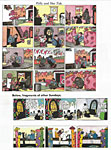
Some
of the gags, as in George Herriman's Sunday Krazy Kat, seem
dictated by the cartoonist's desire to draw certain subjects in certain ways,
often experimental. One March 1927 page is devoted entirely to midnight scenes
around the Perkins house. We watch Kitty wander through pitch-dark rooms, parts
of which are eerily illuminated by the moonlight streaming in through windows,
creating fantastic patterns and shapes, while we overhear Paw and Maw, provoked
by Polly's sneezing, discussing the state of her health. 
When
the family goes to the beach that year (as it does nearly every summer), we are
treated to an entire page in which we see only those portions of the characters
that are underwater while they are wading. Another time, we go with Paw on a
hunting jaunt through the woods—chiefly, I suspect, because Sterrett wanted to
render trees with polka-dot trunks (or striped or flowered).
Some
of the gags are positively vacuous. One Sunday, Maw forces Paw to stay home in
the evening with her instead of going to his poker game. For the whole page,
Paw watches Maw fall asleep in her chair while he and Neewah communicate
silently in gestures and glances a plan for him to escape. In the penultimate
panel, Kitty sneezes and wakes Maw, which effectively cancels the escape plan.
A yawn of a yuk. But the treat of the page (and the comedy) is in the
drawing—in Paw's expressions and his wildly abstracted body language.
This
kind of hilarity is Sterrett's forte. We watch Paw's mounting frustration as
he struggles with one bandaged hand to wash the other. Or his antics trying to
swallow a pill by drinking water from a water fountain. Or his inventiveness
in finding a way to avoid the pain of lying down with a sunburn all over his
body.
On
Sunday pages, Sterrett often demonstrated his sure touch with pantomime. On
one page, Paw marches in Futuristic ranks with dozens of tuxedo-clad
opera-goers, up and down hill-and-dale stairs, to get Polly a glass of
water—which, at the last moment, he spills. On another page, we see what Paw
sees when he inadvertently puts on Maw's spectacles instead of his
own—distortion of everything, a Surrealist's dream. And another time, Paw goes
on a fox hunt and wordlessly restores the pursued fox to its family, and we
witness the joyous reunion.
Sterrett's
graphic style has always overshadowed every other aspect of the strip. And
that is entirely appropriate: the satire of his social and domestic humor,
however insightfully constructed through the prism of Paw's discontent, is
whimsical and felicitous but not as impressive as his pictures. Still, his
approach to humor, while not notable, is not negligible either. Mostly,
Sterrett confined himself to the domestic scene, but occasionally, he left the
Perkins house to 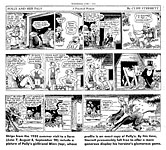 explore other venues of contemporary living. Virtually every
summer, the family made a trip to the seaside. One summer in the thirties,
they went to a farm.In 1927, as I mentioned, we find Paw and Maw and Polly and Kitty and
the whole entourage stranded on that desert isle, far from the usual domestic
context of Sterrett's comedy. explore other venues of contemporary living. Virtually every
summer, the family made a trip to the seaside. One summer in the thirties,
they went to a farm.In 1927, as I mentioned, we find Paw and Maw and Polly and Kitty and
the whole entourage stranded on that desert isle, far from the usual domestic
context of Sterrett's comedy.
The
desert island sequence is scarcely typical Sterrett fare: it is a continuing
story, suspensefully told. While the antics of his cast are comic and the
daily installments often end with punchlines, there is also a good measure of
the kind of suspense we usually find in an adventure continuity, and Sterrett
proves adept at manipulating our engagement by providing a generous helping of
cliff-hanger endings that are both humorous and tantalizing (somewhat in the
manner of Al Capp in Li'l Abner).
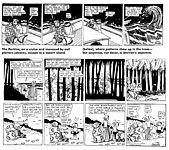 |
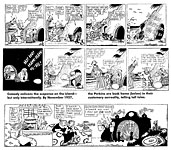 |
Suspense
of this sort is nearly impossible to achieve without establishing an aura of
danger, and Sterrett does that, too. And more. He puts his cast through some
unaccustomed paces. In meeting the risks of day-to-day living on the island,
most of his characters—Ashur, Neewah, Maw, and most particularly Paw—have their
moments of personal heroism. All except Polly. Polly remains throughout a
caricature of the pretty girl—a sort of icon, a wall flower, a mere decoration,
as much a prop in the surreal landscape here as the potted plants are in the
Perkins home, her face forever frozen in its "pretty girl" grimace.
As
Sterrett's style matured into the 1930s, it became somewhat less inventive.
Surrealistic elements disappeared, leaving the geometric forms of Futurism, and
these became the conventions of the strip and wholly predictable.
Understandably predictable. Having initiated a novel and unique way of
rendering a comic strip, Sterrett had little choice but to imitate himself,
which he did, repeating again and again the graphic maneuvers he had introduced
until they became the familiar devices of his treatment.
Polly during the 1930s was less surprising graphically, but I like this period as
well as the more brilliantly innovative 1920s. In the thirties, Sterrett's
line seems bolder; his sense of design in the use of solid blacks and textures,
surer. He seems more confident of his art. (And, of course, he was: he was
repeating designs he had used before, and with repetition comes confidence.)
Here
we find the daily strip in the last of its glorious heydays. Polly is
more richly textured with cross-hatching and shading in the thirties than in
the twenties: the strip is a crazy-quilt cacophony of patterns and textures.
And of visual comedy. Like other supreme masters of the medium, Sterrett drew
funny. His Futuristic abstractions, his Surreal furniture—these were comic
images not philosophical ones. His characters, pop-eyed and cross-eyed
simultaneously, move through the strip by making ambulatory gestures rather
than by actually walking, one foot after the other; they lean over backwards,
trucking along by advancing one foot ahead of them, the other trailing behind
as if being dragged behind by the lead foot. And when they sit down, their
knees come up to their chins, and they are perfect comic abstractions of homo
sapiens seated; and sometimes, when they sit in overstuffed chairs whose arms
are curved, their knees and the chair's arms form a series of perfectly
parallel humps.
And
then there's the omnipresent Kitty. Kitty is Sterrett's Greek chorus: she
stalks Paw in virtually every panel, her posture mimicking his, thereby echoing
his every mood. And when she breaks cadence, the dissonance is a comic comment
on whatever Paw is doing (or is being done to him). 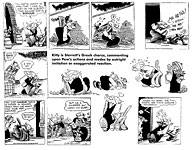
Polly,
meanwhile, appears no more frequently than before (which was not very often, in
case I've failed to mention it). And her every appearance is a static pose:
seated, she displays her porcelain profile with pouting lips, a rounded
shoulder and daintily arched wrist, and lots of leg. Polly had legs that went
on forever—from the knee to the ankle, that is. She is almost always depicted
sitting down because all the other characters are so squat that she'd tower
over them if standing; and when seated, her legs are bent demurely to one side,
knees together, in the classic chaste girl pose..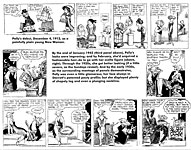
As
before, the daily strips usually pursue a single theme for a week or so at a
time. And the themes are usually quite mundane, scarcely earth-shaking. One
year at Thanksgiving, for instance, we find Paw preoccupied by the goose he has
purchased for the feast. A live bird, the goose soon wins Paw's affection over
the few days it is around before the holiday, and thus it avoids the dinner
platter.
Next,
the Perkins family faces Christmas. Sterrett always did a special Christmas
sequence, and the inventiveness of his treatments are a joy to witness. Santa
Claus usually makes an appearance, and marvelous things result. In 1933, Santa
turned the entire cast into Christmas toys for the season: everyone had
doweling for arms and legs, wooden balls for heads. (The sequence is virtually
prototypical of the graphic treatment of the strip itself in the 1940s.)
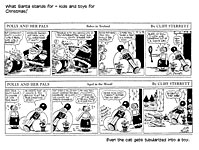 |
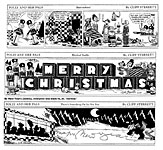 |
In
1931, the Yuletide predicament is how to find a present for Paw, who is one of
those souls who have everything. Polly and Maw solve the problem by throwing
out all his slippers, pipes, bathrobes, etc., so there will be something they
can get for him. Then a New Year's resolution leads to Paw crusading against
the brat Gertrude, followed by a search for a suitable governess for the
child. Later everyone gets spring fever for a couple weeks, then Ashur gets a
kangaroo to train as a boxer, after which, new neighbors move in next door and
baffle the Perkins with their behavior. And so on and on.
By
the 1930s, Sterrett was assaulting Paw less and less with the idiocies of the
Modern Age; indeed, the notion of "the Modern Age" was fading by
then. But Paw is still the thematic center of the strip: Polly is now
entirely a family situation comedy with Paw the archetypal pater familias, forever put upon by his numerous relatives, forever astonished by their foibles
and foolishnesses. The humor now arises from Sterrett's systematic deflation
of pomposity and arrogance. He ridiculed personages with these character flaws
by placing them in circumstances in which they come face-to-face with their own
shortcomings—a maneuver that reveals with comic effect just how far short they
fall of their good opinions of themselves.
Sterrett
was a master of pantomime, particularly, as I said, in the Sunday strips, but
he mined the verbal as well as the visual for humorous nuggets. He delighted
in the comedy that occurs when stupid people misinterpret common expressions by
taking them to mean literally what they say, but his sense of word-play
included all kinds of verbal gymnastics.
Ashur
hesitates to marry because he's afraid of failure. There ought to be a law, he
says, to make marriages "fool-proof." Paw, overhearing this,
disagrees: "What we needs is a law t'make fools marriage-proof."
Later,
Paw gets into a game of one-upsmanship with his neighbor over the scarecrows
they have in their gardens. Maw tells Paw that their scarecrow looks shabbier
than the neighbor's, so Paw hangs a tuxedo and a top hat on the scarecrow
frame, saying, "Let's see 'im 'top' that."
On
a summer voyage, Neewah gets seasick, and Paw tries to comfort him by saying
he'll soon get his sea-legs. "Too late, honorable Pa," says Neewah,
"—of what use are limbs to a man without a stummick?"
By
the 1940s, Polly is thoroughly stylized graphically into an endless
reprise of itself. It is still a pleasure to behold, though– with its daringly
abstract interpretations of human anatomy and its bold design quality. By
then, however, much of the work in Polly was no longer Sterrett's.
Plagued by rheumatism, he was forced to give up the daily strip. Paul Fung
took it over on March 9, 1935, after which the dailies appeared without
signature: Sterrett refused to sign work he didn't actually do. But his
signature continued appearing on the decorative Sunday strip until it ended
June 15, 1958.
Whether
in the Surreal twenties or the Depression thirties, Polly always had
about it a wholesome homespun quality just a little musty with resonances of a
by-gone age. But if the ambiance of the strip was somewhat dated in this
fashion, it is not a fault that interfered with its sense of humor. Given the
time-warped setting, Sterrett was as comfortable in the thirties as he had been
in the two preceding decades, and the tics and tropes of his idiosyncratic cast
are as amusing today as they must have been then. But the real entertainment
in Sterrett's strip is found in the cartoonist's unique and highly comedic
stylistic graphic interpretation of the human form and its environment.
Sources. Polly and Her
Pals (the first year)
by Cliff Sterrett (Hyperion Press, 1977); The Complete Color Polly and Her
Pals, Vols. 1 and 2 (1926-1929; Remco Worldservice Books, 1990 and 1991); Polly
and Her Pals (1931 dailies; Arcadia Publications, 1990); 5 issues of Polly
and Her Pals comic book (1927 dailies; Eternity Comics, October 1990 -
January 1991); Polly and Her Pals (1933 dailies, IDW, 2013); Comics
and Their Creators by Martin Sheridan (1944; rpt. Luna Press, 1971);
Coulton Waugh’s The Comics (Macmillan, 1947); Comic Art in America by
Stephen Becker (Simon and Schuster, 1959); plus Modern Art in the Making by
Bernard S. Meyers (McGraw-Hill, 1950); Art of the Western World by Bruce
Cole and Adelheid Gealt (Simon and Schuster, 1989); and Art: The Twentieth
Century by Flaminio Gukaldoni (Skira, 2008).
Return to Harv's Hindsights |